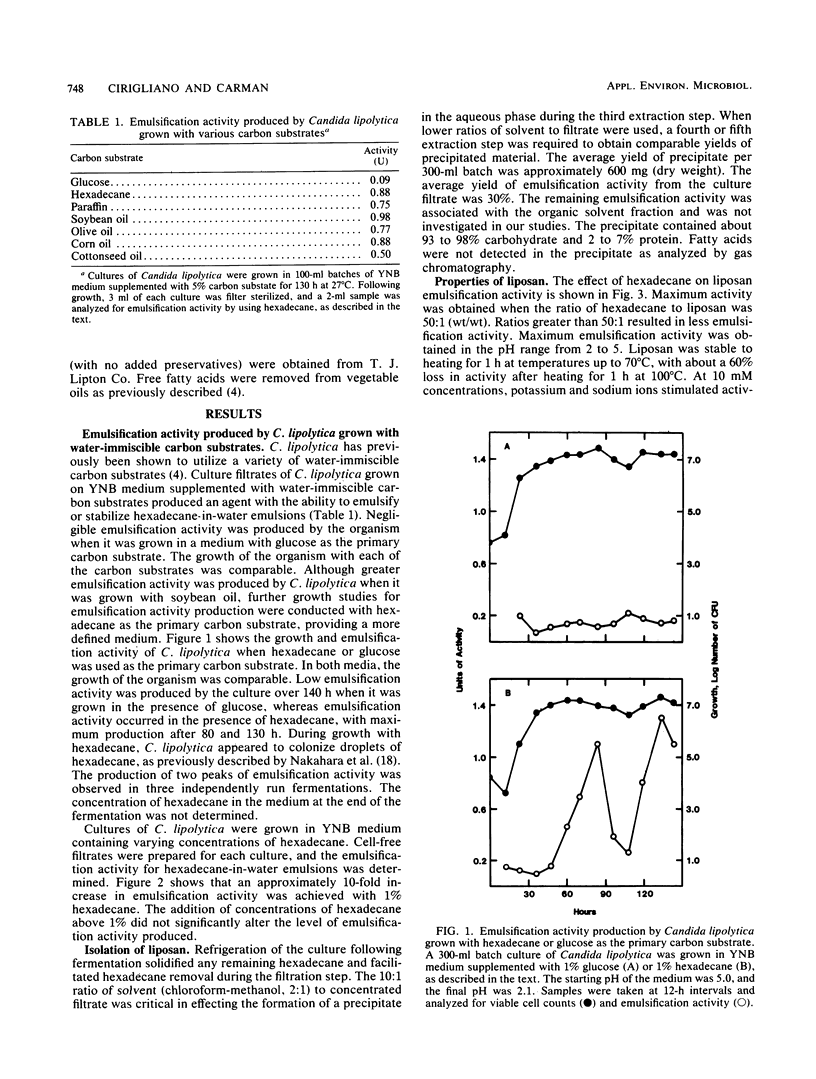Abstract
The yeast Candida lipolytica produced an inducible extracellular emulsification activity when it was grown with a number of water-immiscible carbon substrates. Negligible emulsification activity was produced by this yeast when it was grown with glucose as the carbon substrate. In hexadecane-supplemented cultures, emulsification activity was first detected after 36 h of growth, with maximum production after 130 h. A water-soluble emulsification activity was partially purified by repeated solvent extractions of the culture filtrate. This emulsifier, which we named liposan, was primarily composed of carbohydrate. Maximum emulsification activity was obtained when the ratio of hexadecane to liposan was 50:1. Maximum emulsification activity was obtained from pH 2 to 5. Liposan was heat stable to temperatures up to 70 degrees C, with a 60% loss in activity after heating for 1 h at 100 degrees C. Liposan effected stable oil-in-water emulsions with a variety of hydrocarbons.
Full text
PDF



Selected References
These references are in PubMed. This may not be the complete list of references from this article.
- Bradford M. M. A rapid and sensitive method for the quantitation of microgram quantities of protein utilizing the principle of protein-dye binding. Anal Biochem. 1976 May 7;72:248–254. doi: 10.1016/0003-2697(76)90527-3. [DOI] [PubMed] [Google Scholar]
- Cooper D. G., Paddock D. A. Production of a Biosurfactant from Torulopsis bombicola. Appl Environ Microbiol. 1984 Jan;47(1):173–176. doi: 10.1128/aem.47.1.173-176.1984. [DOI] [PMC free article] [PubMed] [Google Scholar]
- Gutnick D. L., Rosenberg E. Oil tankers and pollution: a microbiological approach. Annu Rev Microbiol. 1977;31:379–396. doi: 10.1146/annurev.mi.31.100177.002115. [DOI] [PubMed] [Google Scholar]
- Ito S., Inoue S. Sophorolipids from Torulopsis bombicola: possible relation to alkane uptake. Appl Environ Microbiol. 1982 Jun;43(6):1278–1283. doi: 10.1128/aem.43.6.1278-1283.1982. [DOI] [PMC free article] [PubMed] [Google Scholar]
- Jobson A., Cook F. D., Westlake D. W. Microbial utilization of crude oil. Appl Microbiol. 1972 Jun;23(6):1082–1089. doi: 10.1128/am.23.6.1082-1089.1972. [DOI] [PMC free article] [PubMed] [Google Scholar]
- Kretschmer A., Bock H., Wagner F. Chemical and Physical Characterization of Interfacial-Active Lipids from Rhodococcus erythropolis Grown on n-Alkanes. Appl Environ Microbiol. 1982 Oct;44(4):864–870. doi: 10.1128/aem.44.4.864-870.1982. [DOI] [PMC free article] [PubMed] [Google Scholar]
- Nakahara T., Erickson L. E., Gutierrez J. R. Characteristics of hydrocarbon uptake in cultures with two liquid phases. Biotechnol Bioeng. 1977 Jan;19(1):9–25. doi: 10.1002/bit.260190103. [DOI] [PubMed] [Google Scholar]
- Pines O., Bayer E. A., Gutnick D. L. Localization of emulsan-like polymers associated with the cell surface of acinetobacter calcoaceticus. J Bacteriol. 1983 May;154(2):893–905. doi: 10.1128/jb.154.2.893-905.1983. [DOI] [PMC free article] [PubMed] [Google Scholar]
- Prokop A., Ludvik M., Erickson L. E. Growth models of cultures with two liquid phases. 8. Experimental observations on droplet size and interfacial area. Biotechnol Bioeng. 1972 Jul;14(4):587–608. doi: 10.1002/bit.260140405. [DOI] [PubMed] [Google Scholar]
- Rosenberg E., Perry A., Gibson D. T., Gutnick D. L. Emulsifier of Arthrobacter RAG-1: specificity of hydrocarbon substrate. Appl Environ Microbiol. 1979 Mar;37(3):409–413. doi: 10.1128/aem.37.3.409-413.1979. [DOI] [PMC free article] [PubMed] [Google Scholar]
- Rosenberg E., Zuckerberg A., Rubinovitz C., Gutnick D. L. Emulsifier of Arthrobacter RAG-1: isolation and emulsifying properties. Appl Environ Microbiol. 1979 Mar;37(3):402–408. doi: 10.1128/aem.37.3.402-408.1979. [DOI] [PMC free article] [PubMed] [Google Scholar]
- Zajic J. E., Guignard H., Gerson D. F. Emulsifying and surface active agents from Corynebacterium hydrocarboclastus. Biotechnol Bioeng. 1977 Sep;19(9):1285–1301. doi: 10.1002/bit.260190904. [DOI] [PubMed] [Google Scholar]
- Zajic J. E., Guignard H., Gerson D. F. Properties and biodegradation of a bioemulsifier from Corynebacterium hydrocarboclastus. Biotechnol Bioeng. 1977 Sep;19(9):1303–1320. doi: 10.1002/bit.260190905. [DOI] [PubMed] [Google Scholar]
- Zajic J. E., Supplisson B. Emulsification and degradation of "Bunker C" fuel oil by microorganisms. Biotechnol Bioeng. 1972 May;14(3):331–343. doi: 10.1002/bit.260140306. [DOI] [PubMed] [Google Scholar]
- Zuckerberg A., Diver A., Peeri Z., Gutnick D. L., Rosenberg E. Emulsifier of Arthrobacter RAG-1: chemical and physical properties. Appl Environ Microbiol. 1979 Mar;37(3):414–420. doi: 10.1128/aem.37.3.414-420.1979. [DOI] [PMC free article] [PubMed] [Google Scholar]


